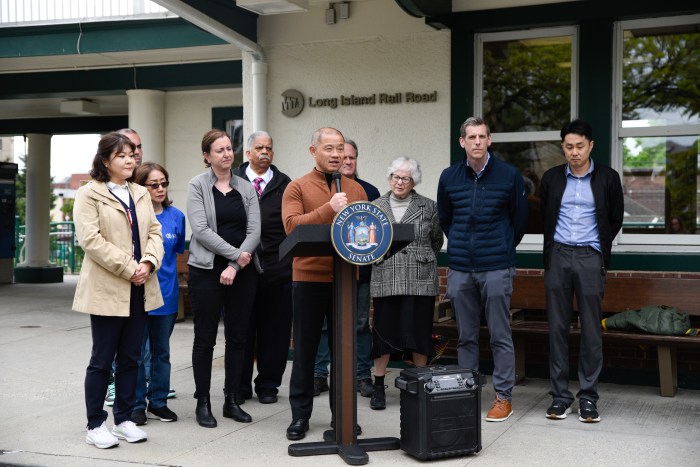By Charles Hack
Cortelyou Road is a racetrack with cars smashing into stoops, flattening trees and running down pedestrians — but the Department of Transport can do nothing to slow the traffic between Brooklyn and Schenectady avenues. That’s what frustrated East 43rd Street Block Association residents heard at a Community Action Project-sponsored meeting at St. Therese Church on Avenue D at Troy Avenue on May 12. “They don’t call it Cortelyou Road any more, they call it Cortelyou highway,” said John Blount, president of the Block Association, who said he woke up 1.30 a.m. one morning to find smoke and steam poring up from a car that had smashed into the stoop of his home on the corner of East 43rd Street and Cortelyou Road. “They had to lift the car off of my porch,” said Blount. “They tore my whole stoop off — $9,000.” In another incident, in Sept. 29 last year, a car went off the road, hit a child, smashed through the fence, tore up the front lawn, and plowed in the house of another Cortelyou Road resident, Keith Adams. One hundred and ninety nine residents signed a petition, saying that speed on Cortelyou Road is a “major problem,” said Matthew Alexis. The St. Therese Local Organizing Committee wants traffic-calming measures and at least three more traffic lights along Cortelyou Road, between Brooklyn and Schenectady avenues — or speed bumps. But the DOT has conducted several studies on Cortelyou Road, and no junctions meet the criteria necessary to install new traffic lights. A study was conducted at Troy Avenue in July 2004, said Dalila Hall, a planner at the DOT’s Brooklyn Borough Commissioner’s Office, using accident statistics supplied by the 67th Precinct. “The intersection didn’t warrant any speed control device,” said Hall. Nor can the DOT install speed bumps because the blocks are too short, and the bumps would be closer than 15 feet to fire hydrants and five feet to manholes and driveways, Hall said. Community Action has had more success persuading the police to implement stricter enforcement. In 2004 the police recorded 22 accidents on the strip of Cortelyou Road from Brooklyn to Schenectady Avenues. There were seven accidents for the first two months of 2005, before the police intensified issuing summonses and citations. In the following two months there were just four accidents — a decrease of 43 percent, said Captain Elias Nikas, executive officer of the 67th Precinct. Nikas stepped up enforcement along the stretch, issuing 50 summonses since March, after he met with Blount and a CAP representative. “They know we are setting up shop,” said the captain, who is using radar equipment to trap speeders. Cops are issuing more summonses for speeding, driving with cell phones, light jumping, broken tail lights and driving through stop signs, he said. There are just three sets of traffic lights along the 20-block stretch, one each at Brooklyn, Schenectady and Albany avenues. But the DOT says there just isn’t enough evidence to support more traffic lights. The community would have to wait 18 months between each study, unless the precinct gives the DOT additional data, Hall said. The last study was conducted in 2004 when officials pored over accident statistics and traffic counters stood 24-7 at intersections, measuring pedestrian and vehicular traffic. The DOT also looks to see if turning vehicles, and traffic moving from a side street into the main street, would be helped by lights. “If there’s any new information they have to share with us, we would be happy to take that back and reopen a study,” Hall said. But she said traffic lights are not a traffic slowing measure — they are there to prevent accidents at busy intersections. “Sometimes lights increase the speed of traffic because people see the lights and race to make it,” Hall said. But Nikas says that it is more to do with recent changes to the timing of the traffic lights. “I feel if we changed the sequence of the light it would slow the traffic,” Nikas said. “Late in 2003 and the first part of 2004 the lights were staggered differently. Ever since these lights were reconfigured, motorists find it acceptable to accelerate to make the lights.” Community Board 17 chair Michael Russell called on the DOT to respond to the community concerns. “I think one of the important criteria is the community – and they are begging,” Russell told the DOT representative. “Isn’t there something else we can do?” He said that the community board had been making phone calls and writing letters. “We will continue the dialogue with the precinct to see if there is any more information,” Hall said. “We understand the community is living with this.” But she said that the DOT needs more evidence of accidents. “Basically the two words are ‘red tape,’” said one resident. “In order to speed up the process, somebody has to die – you need a tragedy. It’s just study, study, study.” The members wanted to hold the DOT and Community Board 17 accountable. Brenda Woodriff asked that Hall answer the following questions: Does the DOT commit to conducting a study by July 2005 and commit to meeting with the local organizing committee within two weeks of the study being completed? With a marker pen, Hall checked all the “yes” boxes and signed underneath each question that had been posted on the wall. Woodriff then asked whether Community Board 17 committed to ensure the traffic study is enforced. Again, Russell checked “yes.”































